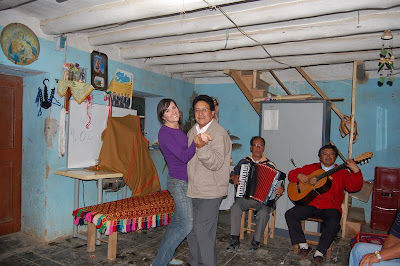As I write this blog post, I am finding it difficult to lift my fingers high enough to type. This little gringa is exhausted! Last month San Miguel’s annual festival came blowing through town like a hurricane and nearly took me out in the process. Seventeen days of no work and all play can be seriously strenuous. This marked my second, and last, San Miguel festival, so I was determined to live it up… I also have more friends than I did last year, so they forced me to stick to that vow.
What resulted was a string of nights where we danced til 5 am, then started dancing again at 6 am, breaking only to drink some soup for breakfast. The events were essentially the same as last year (parades, towers of fireworks and marching bands galore), so I’ll spare you the redundancy. What the festival made me realize, however, is that I haven’t fully explained the party process in all of its sordid details. Trust me, after a year of living with this particular family in this particular town, I’ve got it down to a science.
It really is a fascinating thing to behold, in that every celebratory party, whether it is a birthday party, wedding reception or even a funeral, follows the same precise pattern. I know I would be doing you all an injustice if you find yourself in the middle of a Peruvian fete and you didn’t know which way to pass the glass. So here goes, I offer you the instruction manual that I have pieced together during my many months of partying:
1. Do not show up on time. Trust me, I’ve learned this the hard way, showing up to somebody’s house and having the hostess usher me inside to sit by myself for two hours while she washes her hair. Under close study, I have formulated a general guideline. For weddings, show up 30 minutes after the advertised time, one hour for funerals and baptisms, and two hours for a birthday party. The only two events that start on time here are Mass and Bullfights.
2. Once you arrive, greet every person in the room (with a kiss on the cheek for ladies and a hand-shake between men), then sit down, do not talk and stare off into space without making eye contact with anyone. Usually the chairs are arranged in a circle, so it can prove difficult not to catch a stray eye here or there. It takes practice, so do not expect to master it at your first few parties. This first stage of the party usually only lasts for about half an hour, and you’ll know it has ended when the host and his/her minions begin to pass out napkins and plastic utensils.
3. Next comes Meal #1. Typically it involves a questionable piece of meat, rice, potatoes and a vegetable (vegetable = one piece of lettuce). Just a smaller version of your lunch, so nothing exciting there. What makes it fun is trying to cut the mystery meat with a plastic spoon, while balancing the small Styrofoam plate on your lap. Add to that a Dixie cup of Inka Cola and you can just picture the awkwardness that ensues. An important note: don’t forget to bring a few little plastic bags in your pocket for leftovers. Say it’s for your dog.

Every party requires a small staff to prepare the food

The man above demonstrates an excellent balance-your-plate-on-your-lap technique.
4. Speaking of awkwardness, the next phase is without a doubt my favorite. Awkward Speeches!! Beginning with the host and moving around to many of the attendees, each person spends a good five minutes thanking one another for attending or throwing the soiree. The longer your speech, the better. Bonus points if you specifically name and thank 90% of the people in the room. And don’t think that I don’t share in the fun. I have my standard speech, requiring slight tailoring based on the situation that I have given more than a dozen times.
It doesn’t really matter what you say. At Host-Mom’s birthday, I watched as three people who had just roamed in off the street (we always keep the door open on party nights, no matter how cold it gets) and barely knew her gave heart-felt toasts. I really don’t want to Peru-bash and/or stereotype here, but this is a genuine observation that I have made over the last year. Peruvians are really horrible public speakers. And yet they continue, celebration after celebration, to stand up and say their peace. You’ve gotta respect that.

Host-Mom is a master at the speech...
5. Once the speeches have concluded, everybody gets to down their thimble-sized cup of wine… the sweeter the wine, the better. This serves as a sign that the drinking portion has begun, and those who do not want to partake should go ahead and leave. I’ve never actually seen anybody leave, though. Breast-feeding mothers, five year-old children, Priests, Nuns, the elderly, the disabled. They all stay for at least a round or two (and often many more) of the drinking circle.
The drinking circle is perhaps the thing that most differentiates a Peruvian party from its North American counterpart. The host brings out one bottle (of beer or canazo) and one glass. He pours an appropriate amount into the glass and passes the bottle on to the person at his immediate left – this is VERY important, the bottle must be passed on before drinking. This is his way of saying “Cheers” to everyone. He then drinks the entire contents of the glass as quickly as possible (others are waiting for their turn, after all), occasionally accompanied by a nod of the head and tip of the glass to his neighbor out of politeness and camaraderie. Then, before passing the glass on to his neighbor, he dumps the remaining contents of the glass (foam and/or leftover drops of the beverage) into a communal bowl strategically set in the middle of the drinking circle… or if no bowl is handy, onto the floor. This act serves two functions. First, on a practical level, it clears out the nasty backwash issue that arises when dozens of people are sharing one cup. Second, it symbolically gives a drink to “Pacha Mama,” which is quechua for Mother Earth.
This process continues around and around the circle for the remainder of the night. Simple enough, but a few factors can complicate it. If a man is standing next to a woman, he will often serve her first. If a man is standing next to five women, he’ll go down the line and serve all of them before taking his own turn. Then it can become confusing when dancing begins, as the perfect circle becomes a little discombobulated. But by that point, most are too tipsy to notice or care.
Here's a visual for you:
 Lady with the hat passes bottle to boy on her left (let's just ignore the fact that he is clearly not drinking age, shall we?)
Lady with the hat passes bottle to boy on her left (let's just ignore the fact that he is clearly not drinking age, shall we?)
Boy pours himself a little...

After passing the bottle along, he drinks...

After dumping contents on the floor, he passes along the cup. Continue ad nauseum.
6. Although the music comes on as soon as the speeches wrap up, dancing does not begin until the drinking circle has gone around a few times. They may be Latin in more ways than one, and the opposite of timid when it comes to asking personal questions and professing their love for you, but Peruvians can be shy to dance until they have the proper incentive.
Enjoy this time, though, because once the dancing begins, do not expect to get much of a rest for another six hours or so. Everybody seems to agree at the same time that it is time to dance, but women have to wait for a man to ask her to dance. You don’t really see groups of girls dancing together, as in the United States. No, no, it must be a one-guy-to-one-girl affair. Also it is considered rude for a woman to turn down a dance request from any man. It reminds me of a 1950’s High School dance, except for the booze, of course.



7. As aforementioned, dancing ensues and dominates the scene for the remainder of the party. It is only interrupted for a series of small meals, depending on how long the party goes on. Meal #2 is usually (in San Miguel, at least) a cup of pre-sweetened coffee and a small plate piled high with cheese, bread and cake. Note: here is another great opportunity to use those little baggies you brought along. This cake is not to be confused with the “Fill-in-the-event Cake,” which will come out later. When the official cake is served, you usually have another round of speeches and shots of sweet-wine. These speeches, I’m sure you can imagine, are a lot more fun to witness.

They seem to be really enjoying their cake and jello, right?
8. Drinking continues and dancing gets more intense. You often find whoever is controlling the stereo will begin playing the same three or four songs over and over again… the real crowd-pleasers. At this point (most) guests with small children begin to filter out first, followed by older people and people who can’t dance (unless they’re directly related to the host). Then there’s a three hour gap where nobody leaves. This is the real party time. Usually the host will fish out a few old Coke bottles filled with unidentifiable liquor and add them into the drinking circle. Several beer runs inevitably take place. LOTS of posed photographs are requested and taken. As a rule of thumb, the party doesn’t die until: A.) The alcohol (and money to buy more alcohol) runs out, or B.) The sun comes up. I’ve seen plenty of both endings.

Posed-Photo time!

Often you think the party is about to end... then somebody rolls in last minute to save the day.

5:30 a.m. and the party is still rolling on!
So there you have it, in a nutshell. I’ve come to really enjoy the Peruvian party and its quirky nuances. Nothing has taught me more about the culture of this community and how greatly they esteem communal bonds, created through sharing a meal, a dance and a cup.
A few more visuals for you:

No bottle-opener? No problem! I've learned to open a bottle using the lid of another bottle.
(I'm currently at 65% accuracy, but hoping to have it down pat before returning to the States.)






